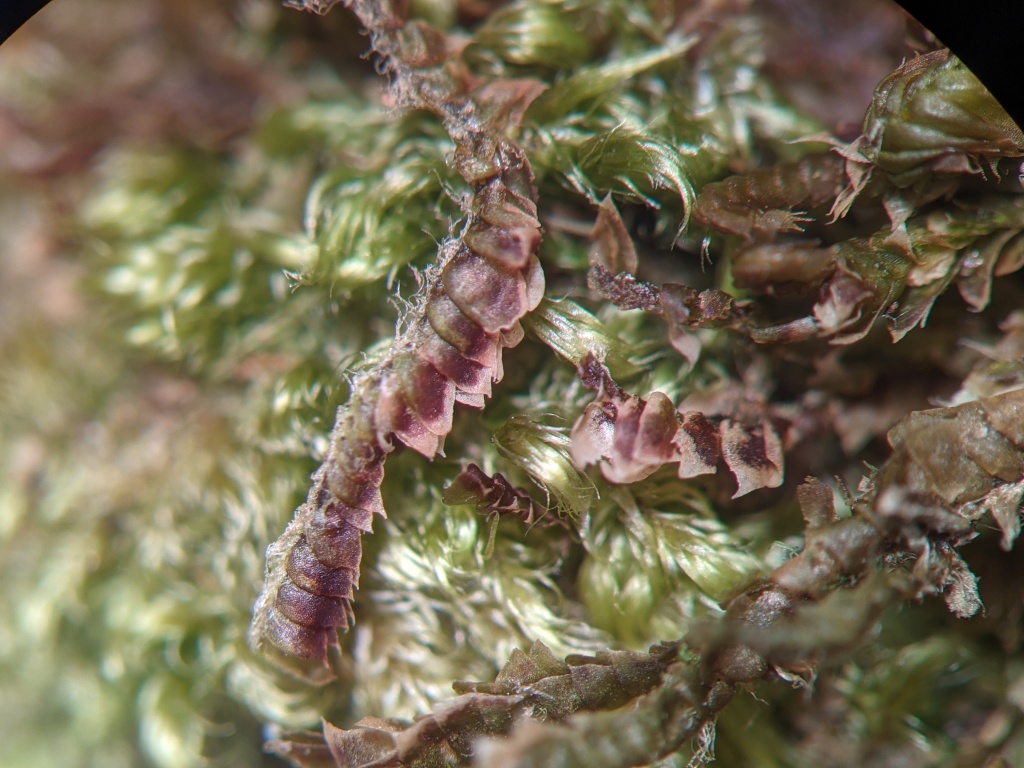Adelanthaceae
Epiphytic, lithophytic, on logs or terrestrial, dioicous. Asexual reproduction by gemmae produced at stems apices (not in Victoria) or (not in Victoria) intercalary on leafy or leafless stems, or rarely by caducous leaves (not in Victoria). Stems prostrate to erect or pendulous, sometimes differentiated into highly branched creeping axes without leaves or with reduced leaves and erect leafy axes, with unbranched or irregularly and sparingly branched leafy axes, with two ranks of lateral leaves, with or without distinct underleaves, rarely with paraphyllia; branches emerging from stems laterally or from ventral side of stem and with a collar of tissue at base, or next to narrowed lateral leaf and without a collar of tissue at base. Lateral leaves ovate, lanceolate, orbicular, reniform, elliptic (not in Victoria), lingulate (not in Victoria) or obovate (not in Victoria), transverse to succubous, alternate or opposite (not in Victoria), sometimes fused, remote to imbricate, widely spreading perpendicular to stem to vertically oriented and secund in the direction of the ventral stem, unlobed or bilobed, rarely deeply bilobed, entire, denticulate, dentate or bidentate to biciliate, rarely laciniate at base, rarely erose, plane or revolute to incurved along basiscopic margin, rounded, emarginate or acute to piliferous at apex. Underleaves if present reduced to cilia (not in Victoria), connate to lateral leaves forming small lobes, small, simple and filiform to lanceolate (not in Victoria) or around half the size of lateral leaves, with two divergent ovate to lanceolate lobes; leaf cells quadrate, circular, elliptic, oblong, polygonal or irregular, smooth, verrucose (not in Victoria) or pluripaillose, thin- to thick-walled, sometimes becoming more elongate toward basal centre, rarely forming a differentiated border of thicker-walled cells along margin, with or without distinct trigones, unistratose throughout or (not in Victoria) rarely pluristratose at leaf base and sometimes margin, with 3–20 oil bodies; oil bodies ellipsoid, obloid or spherical, granulate to granular-botryoidal, colourless. Rhizoids when present scattered on ventral side of creeping stems or sometimes at base of erect stems, rarely in fascicles from lateral leaf base (not in Victoria), without peg-like internal thickening, hyaline. Androecia intercalary on main axes or forming reduced branches arising from base of leafy stem below leaves or from leafless creeping stems, with 1–10 pairs of ventricose bracts, each with 1–3 antheridia. Sporophyte terminating main stem or on short branches without normal leaves arising from base of leafy stems or from leafless creeping stems, subtended by bracts and usually developing within a perianth and occasionally a shoot calyptra; bracts usually strongly differentiated from leaves, usually being more dissected and dentate, with 2–3 lobes, rarely unlobed; shoot calyptra when present green, fleshy, sometimes becoming large and clavate; perianth rarely absent or vestigial and dissected into bract-like segments, or well-developed, ovoid, ellipsoid, obloid or obovoid (not in Victoria), trigonous, sometimes pluriplicate towards mouth or rarely throughout, with entire, crenulate or ciliate to dentate and often lobulate mouth; capsule ellipsoid or ovoid, 3–8-stratose, dehiscing by 4 valves; elaters present, bi- or tri- (not in Victoria) spiral; spores globose, tuberculate, papillose, granulate, vermiculate or verruculose, shed singly.
Eleven genera and 68 species shared between southern temperate regions and oceanic islands, Subantarctic regions, East Africa, Madagascar and the Mascarene Islands, the Seychelles, south-east Asia through to the tropical Pacific, Britain, Ireland, France, Macaronesia and South to Central America and the Caribbean (Schuster 2002; Söderström et al. 2016); five genera and eight species in Victoria.
Schuster, R.M. (2002). Austral Hepaticae Part II. Nova Hedwigia Beiheft 119. Cramer in der Gebrüder Borntraeger Verlagsbuchbehandlung: Berling & Stuttgart.
Söderström, L., Hagborg, A., von Konrat, M., Bartholomew-Began, S., Bell, D., Briscoe, L., Brown, E., Cargill, D.C., Costa, D.P., Crandall-Stotler, B.J., Cooper, E.D., Dauphin, G., Engel, J.J., Feldberg, K., Glenny, D., Gradstein, S.R., He, X., Heinrichs, J., Hentschel, J., Ilkiu-Borges, A.L., Katagiri, T., Konstantinova, N.A., Larraín, J., Long, D.G., Nebel, M., Pócs, T., Puche, F., Reiner-Drehwald, E., Renner, M.A.M., Sass-Gyarmati, A., Schäfer-Verwimp, A., Moragues, J.S., Stotler, R.E., Sukkharak, P., Thiers, B.M., Uribe, J., Váňa, J., Villarreal, J.C., Wigginton, M., Zhang, L. & Zhu, R. (2016). World checklist of hornworts and liverworts. Phytokeys 59: 1–828.
 Spinning
Spinning